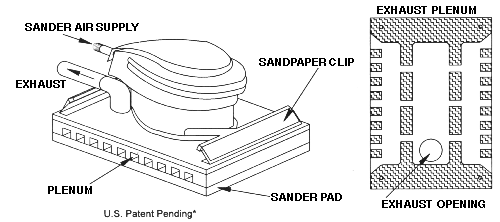Orbital hand sanders have been found to create significant amounts of wood dust. Workers exposed to wood dusts have experienced a variety of adverse health effects such as eye and skin irritation, allergy, reduced lung function, asthma, and nasal cancer. Therefore, the National Institute for Occupational Safety and Health* (NIOSH) recommends limiting wood dust exposures to prevent these health problems. (*NIOSH is the Federal agency responsible for conducting research and making recommendations for preventing work-related illness and injuries. HAZARD CONTROLS are based on research studies that show reduced worker exposure to hazardous agents or activities.)
NIOSH researchers found that the wood dust generated by orbital hand sanders is often poorly controlled. To address this problem, researchers designed and tested a new control system for these hand sanders that significantly reduced dust emissions.
DUST CONTROL SYSTEM ILLUSTRATION:
DUST CONTRO
For More Information
To obtain more information about controlling this hazard, or for information on other occupational health and safety issues, call NIOSH at: 1-800-35-NIOSH (1-800-356-4674)
A technical article Controlling Wood Dust from Orbital Hand Sanders has been accepted for publication. Also, a videotape New Control for Orbital Hand Sanders, Tape# 208, 5 minutes, may be borrowed free of charge.
This document is one in a series of seven HAZARD CONTROLS concerning wood dust control techniques listed below that are available free upon request from NIOSH:
The principal contributors to this HAZARD CONTROLS are Jennifer L. Topmiller, Division of Physical Sciences and Engineering, and Jerome P. Flesch, Education and Information Division, NIOSH.
This document is in the public domain and may be freely copied or reprinted. NIOSH encourages all HAZARD CONTROLS be made available to all interested employers and workers.
Publication #: 96-126
For more information about these or other occupational safety and health concerns, call toll free: 1-800-35-NIOSH
Disclaimer and Reproduction Information: Information in NASD does not represent NIOSH policy. Information included in NASD appears by permission of the author and/or copyright holder. More